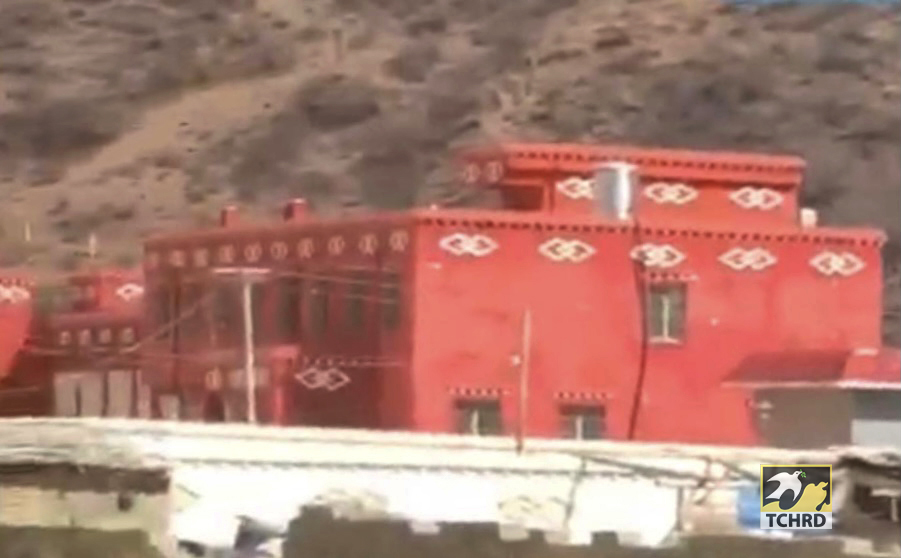Following the demolition of two giant Buddha statues, Chinese authorities have launched a sweeping crackdown on both lay and monastic communities in an attempt to stop any information about the crackdown from being shared online in Drango (Ch: Luhuo) County, Kardze (Ch: Ganzi) Tibetan Autonomous Prefecture, Sichuan Province, in the Tibetan province of Kham.
At least 10 known Tibetans were detained last month among whom was a woman named Lhamo Yangkyi from Trolpa Village. Tenzin Nyima and Tashi Dorje, both monks from Drango Namgyal Ling Monastery (also known as Drango Monastery), were detained on 1 January. Another man named Tsering Samdup from Norpa nomadic camp and six other unidentified Tibetans were also detained three days later.
Most detainees are being held in a ‘re-education’ facility at Thangnakma near Dropa (Ch: Zhuba / 朱巴村) Village, about 5 km from Drango County town. It was formerly a police station that was converted into a ‘re-education’ facility in 2012 when many Tibetans were detained for staging massive protests in Drango.
TCHRD has obtained a satellite image and a photo of the ‘re-education’ facility the outside façade of which is built to resemble a traditional Tibetan house or a temple.

It appears that the police station at Thangnakma was built after the 2008 Tibetan uprising. A source told TCHRD that Thangnakma used to be a barren landscape in early 2002 and the police station was not widely known among the public until it was expanded into an extralegal facility for so-called re-education to detain and punish dissenters outside the domestic legal system.
“These ‘re-education’ facilities where Tibetans are held without charge or trial and subjected to discretionary police power are illegal. It is evidence that Chinese authorities are running yet another form of the dreaded ‘Re-education Through Labour’ system that China claimed to have abolished in 2013,” said Nyiwoe, a researcher at TCHRD.
Sources informed TCHRD that besides being ‘re-educated’ in the Thangnakma detention facility, the detainees have also been subjected to forced labour and custodial torture that led to Tenzin Nyima suffering an eye injury.
Several other Tibetans had also been detained for showing signs of resistance against the demolition and for sharing the news about it with outsiders. Their identities cannot be ascertained immediately due to increased government surveillance.
The plight of Pelga and Nyima, the abbot and the administrative head respectively of Drango Monastery, cannot be ascertained. Both had been detained by the police in October last year, about 15 days prior to the demolition of Drango monastic school. Their current condition and whereabouts remain unknown.
In another sign of widespread crackdown, the Drango County police detained three Tibetan pilgrims after they were found with photos of the recently demolished statues on their phones. The pilgrims identified as Asang, Dorta and Nortso were returning to their hometown in Dragyab (Ch: Zhag’yab) County in Chamdo (Ch: Changdu) City, Tibet Autonomous Region, after a pilgrimage to Larung Gar Buddhist Academy in Serthar (Ch: Seda) County in Kardze TAP. They had been handed over to the police in Dragyab.
The detention and torture of local Tibetans are the results of ongoing home raids and random phone searches. Local Tibetans found loitering near the sites of the demolition had been forcibly stopped and their phones confiscated for inspection.
The heightened restrictions on social media platforms such as WeChat have caused a chilling effect on the online activities of local Tibetans as they fear communicating their concerns about the ongoing crackdown with Tibetans living outside Tibet.
At least one Tibetan (unnamed due to security concerns) in exile reported having his family members questioned and intimidated by local police in the aftermath of the demolition news becoming public.
Government surveillance of online activities intensified after a national campaign to crackdown on ‘illegal’ online activities and “fake” news was launched in August last year by the Party-state’s Central Propaganda Department in conjunction with nine other Party and government departments and agencies.
A series of arbitrary searches conducted by the local police in late August last year in Wonpo (Ch: Wenbo) Township in Sershul (Ch: Sequ) County in Kardze TAP resulted in the detention of more than a hundred Tibetans without charges for possessing the photos of the Tibetan spiritual leader His Holiness the Dalai Lama.
TCHRD calls on the Chinese authorities to put an immediate halt to the ongoing crackdown on local Tibetans in Drango and elsewhere in Tibet and stop violating the rights to freedom of opinion, expression and information; freedom of religion or belief; and freedom from torture, ill-treatment, and arbitrary detention.
Chinese authorities must close down all extra-legal detention facilities that are used to suppress non-government supported forms of expression and dissent. Tibetans imprisoned in these facilities are treated inhumanely and subjected to extreme psychological pressure to conform to the diktats of the Chinese Party-state including denouncing their revered leader His Holiness the Dalai Lama.
The centre further urges the international community including the UN, foreign governments, human rights defenders and other civil society members to pressure the Chinese government to release all prisoners of conscience as well as to respect and guarantee human rights and fundamental freedoms of the Tibetan people.
